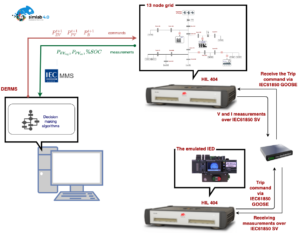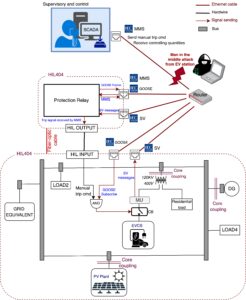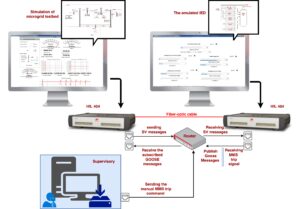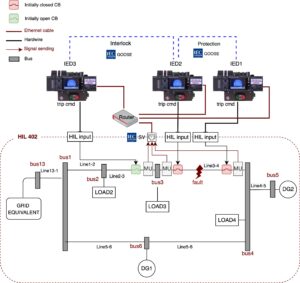This work presents an optimal distributed energy resource management system for a given smart grid connected to photovoltaics, battery energy storage, and an electric vehicle aggregator. These management systems are one of the crucial factors to control the power converters connected to the grid to optimize the power generated by the RES. The proposed management system includes the communication architecture necessary for acknowledging the information flow between the individual control of the distributed generators and the master supervisory control algorithm. The work was carried out on two levels. the first is to design a control strategy for energy management and validate it with the grid in real-time hardware-in-the-loop simulation integrating the IEC61850 communication layer and physically intelligent electronic devices. The second is to analyze the vulnerabilities of the designed methodology for cybersecurity threats explicitly with the extension of IEC61850 to electric vehicle aggregators for communication with the master energy management.
Projects
This project aims to study vulnerabilities in IEC61850 standard MMS protocol widely used in supervisory level of smart grids. A Hardware-in-the-loop testbed setup is designed to investigate cyber-attack vulnerabilities by studying the application of MMS servers in Intelligent Electronic Devices (IEDs). The built-in communication protocols in Typhoon HIL are used instead of conventional co-simulations to study the performance and cyber vulnerabilities of this protocol in a more realistic architecture. A series of data injection attacks are performed on the testbed, first by sniffing the local network and capturing and monitoring the pockets. Then, spoofed data with the same structure are injected into the network to conduct false data injection attacks on the supervisory unit. Vulnerability to cyber-attacks of the IEC61850 protocol in specific situations is proved during this study.
In this project, one particular architecture to inspect Generic Object-Oriented Substation Event (GOOSE) services is proposed. There are two steps for developing the model design for this study. The former resides in the design details of an assumed micro-grid simulation including the communication layer in three levels: supervisory, substation, and the process bus. The latter is, recreating the characteristics of a generic IED running on a real-time simulator device to be used instead of a physical IED. One particular overload scenario is conducted to investigate the performance of the protection mechanisms and IEC61850 services emulated in the IED and the real-time microgrid.
This work includes the hardware-in-the-loop (HIL) simulation methodology of the smart grid including the physical IEC61850 communication network layer using Intelligent electronic devices of circuit breakers. This study recreates a given substation using built-in IEC61850 protocols such as GOOSE messages, SV messages, and MMS server, and the performance is investigated inside the real-time simulation boundaries. The unique aspect of this work is the logic implementation among the protection devices tested with real communication delays over the protocol that can occur between them, and these results are more realistic corresponding to real-world scenarios.




